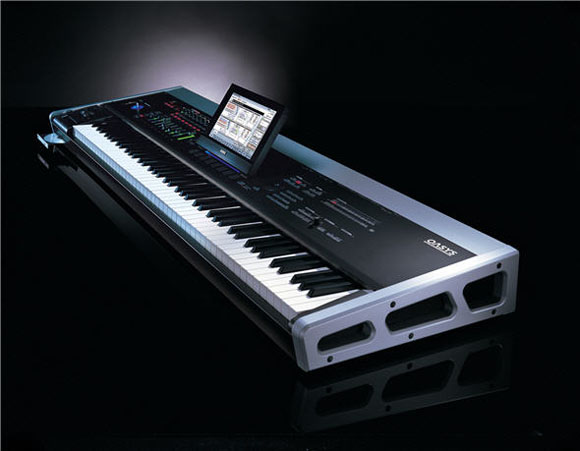Scoop: CDM has learned that this week Korg will announce a major upgrade to its luxurious flagship musical instrument, the Korg OASYS. The free software upgrade, to be available in December, will enhance the OASYS with support for up to 2 GB of RAM, plus enhanced modulation and navigation. That’s nifty, but here’s the big news: Korg is including a major new physical modeling instrument called the STR-1 Plucked String. With radical sound sculpting abilities, it promises to be sound design heaven — and it’s yet another reason to trade your car for a monthly bus pass so you can get your hands on this thing.

A major part of the conception behind OASYS was always expansion capability: running a Pentium PC and Korg’s software, the OASYS can be upgraded without changing the hardware. But the OASYS keyboard wasn’t the first product to be called OASYS. Fans of the old Mac/PC OASYS PCI product were disappointed at the OASYS keyboard’s launch by its lack of physical modeling, a synthesis technique that reproduces the way real-world strings and other materials vibrate, as found on the PCI product. An upgrade featuring this technique seemed inevitable, though, and now it’s here.
Physical Modeling and Sound Design
Physical modeling is useful both for creating realistic, expressive recreations of acoustic instruments and wild, unheard-of sounds not possible in the real world. The ability to have a physical model often makes playing these instruments feel more organic than playing an instrument based on sampled recordings, particularly for certain kinds of patches. It’s the musical equivalent of having a physics engine in a game: the instrument can respond in real-time to your performance, not just by playing back different samples, but by causing a physical model (in this case, the string) to react.
The new STR-1 is, as you’d expect, derived from Korg’s past physical modeling products and research, including the OASYS-PCI, though the OASYS keyboard represents a major upgrade. The basis of the STR-1 is a string model, with 16 different excitation types: plucking, scraping, noise, or even built-in PCM (audio file) waveforms from elsewhere in the OASYS. Of course, if you’re not interested in creating your own sounds or using Peter Gabriel-esque pads, you’ll find plenty of acoustic and electric guitars and basses, clavinets and harpsichords, harps, bells, electric pianos, sitars, and the like, too.
All About Control
You can model physical materials and playing style (damping, harmonics, and powerful settings for dispersion and nonlinearity). An audio input is available, capable of producing some really realistic feedback. (In other words, feed audio correctly, and you can accurately model the sound of a mic placed too close to your guitar amp. Really.) You’ve got the full modulation capabilities of the other instruments on the OASYS, including filters, LFOs, the superb beat-syncable step-sequencer, Korg-trademark vector control, and other features.
Especially exciting is the ability to layer physically-modeled sounds with other OASYS instruments. Layering using the OASYS’ sophisticated voice allocation engine, combined with powerful modulation features give the OASYS some sound and playability capabilities that aren’t possible in software physical modeling products, like Apple Logic Pro’s Sculpture, Native Instruments’ Reaktor, and the Applied Acoustics products. Some of us will (cough) be limited to using those because of the price of the OASYS, but there’s plenty in the OASYS implementation that’s unique. Even if I can’t afford an OASYS in my studio, I’m anxious to play it just to see what Korg’s top-notch designers have done with the sound design and voicing, especially as I’m a huge physical modeling fan.
OASYS Under the Tree?
Korg says the upgrade would be worth US$299 (likely to be the price for future expansion instrument upgrades), but this is one is free. Christmas will be very sweet for OASYS owners — and those of you who get an OASYS for Christmas, well, that’s even sweeter. I’ll check in again once this ships and we have some sound samples.
Incidentally, if you do own an OASYS, I’d love to hear from you. Even if you aren’t Herbie Hancock.
Related:
Korg’s OASYS Synth: How it Was Built, Why it Runs Linux, Why It’s $8,000
Synth Designing Dream Job: Korg R&D’s Dan Phillips